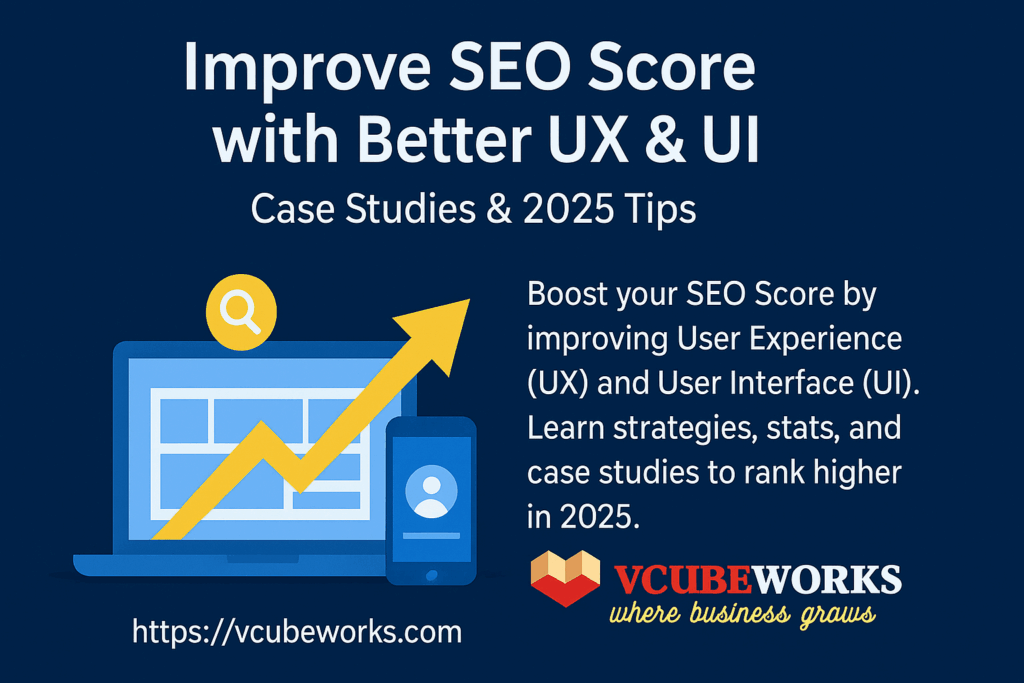In the fast-changing world of digital marketing, two factors now define whether a business succeeds online: User Experience (UX) and User Interface (UI).
- UX (User Experience) is the overall satisfaction and usability people feel when interacting with a website.
- UI (User Interface) is the design layer—layouts, colors, buttons, typography—that shapes how that experience looks and feels.

Together, UX + UI directly impact your SEO Score. A site with poor navigation or cluttered visuals might bring traffic, but users will leave quickly. Conversely, a site with clear UI and smooth UX improves engagement, reduces bounce rate, and strengthens SEO rankings.
Why UX & UI Matter for SEO Score
In earlier days, SEO meant keyword stuffing and backlinks. But today, search engines like Google focus on Page Experience as a core ranking factor.
How UX boosts SEO:
- Lowers bounce rate by keeping visitors engaged.
- Increases dwell time/session duration (users stay longer).
- Improves conversion rates through smoother journeys.
How UI boosts SEO:
- Clean navigation menus make content easier to find.
- Responsive layouts adapt to mobile, tablet, and desktop.
- Visual hierarchy guides users toward actions like CTAs.
👉 Formula for success:
Good SEO brings users in. Great UX + UI keep them engaged and converting.
Case Studies: UX & UI in Action
🔹 Etsy – Better Navigation & Page Speed
Etsy redesigned product pages with faster load times (UX) and a cleaner, more intuitive layout (UI). Result: lower bounce rates and more page views, boosting SEO rankings.
🔹 O’Neill Clothing – Mobile-First UI
By making their UI fully responsive and optimizing UX for mobile-first indexing, O’Neill saw:
- 600% increase in mobile conversions
- 27% growth in organic traffic
🔹 Mailchimp – Content + UI Synergy
Mailchimp improved content readability (UX) and used strong visual hierarchy (UI). This reduced bounce rate and increased engagement—strengthening SEO visibility.
🔹 Dropbox – CTA Design & Placement
Dropbox optimized CTA buttons with clear UI design and concise action words like “Get Started.” This enhanced user flow (UX), boosted conversions, and improved search rankings.
Key UX + UI Elements That Influence SEO Score
- Page Load Speed – 53% of users leave if a site loads in more than 3 seconds (Google).
- Mobile Responsiveness – Over 60% of global searches happen on mobile (Statista, 2025).
- Navigation & Structure – Follow the 3-click rule: users should reach any page in 3 clicks.
- Content Readability – Use short paragraphs, headings, images, and bullet points.
- Call-to-Action (CTAs) – Place CTAs above the fold and use action-driven words.
- Visual Hierarchy & Design – Use fonts, colors, and spacing to guide users.
- Accessibility – Alt tags, ARIA labels, and proper contrast improve inclusivity and SEO.
The 5-Step UX/UI SEO Checklist
- Audit Core Web Vitals using Google Lighthouse and PageSpeed Insights.
- Test Mobile Experience (use Chrome DevTools or Google’s Mobile-Friendly Test).
- Simplify Navigation with clear menus and breadcrumbs.
- Optimize CTAs (button size, placement, colors).
- Measure User Engagement with GA4, Hotjar, or CrazyEgg heatmaps.
Live SEO + UX/UI Statistics (2025)
- Sites with strong UX/UI see 32% higher organic traffic (HubSpot, 2025).
- Mobile-friendly UI designs rank 15% higher in SERPs (Search Engine Journal, 2025).
- A 1-second delay in load speed reduces conversions by 7% (Akamai, 2025).
- 88% of users won’t return after a bad website experience (Forbes, 2025).
- 70% of users judge a company’s credibility based on its UI design (Stanford Web Credibility Study, 2025).
Expert Insights
📢 “Google’s algorithms increasingly reward websites that focus on Page Experience—speed, mobile responsiveness, and interactivity.” – John Mueller, Google Search Advocate
📢 “UX without UI is like a skeleton without skin. UI without UX is like makeup without personality. Both are essential for SEO success.” – NNGroup (UX Research Experts)
AI & the Future of UX/UI in SEO
Artificial Intelligence is reshaping SEO and UX/UI by:
- AI Personalization → delivering custom experiences, lowering bounce rate.
- AI Chatbots → increasing dwell time and engagement.
- Predictive UX → anticipating user behavior and streamlining journeys.
- AI Testing Tools → running A/B tests automatically for UI layouts.
👉 Businesses that integrate AI-driven UX/UI will see stronger SEO Scores in the next 3–5 years.
Q1: Does UX directly affect SEO Score?
✅ Yes. Metrics like dwell time, bounce rate, and engagement are ranking signals.
Q2: How does UI impact SEO?
✅ Clean, responsive, and accessible design makes content easier to consume, increasing conversions and rankings.
Q3: UX vs UI: What’s more important for SEO?
✅ Both. UX is about usability and flow; UI is about visual design. Together, they create a strong Page Experience.
Q4: How do I test UX/UI performance?
✅ Tools: Google Lighthouse, Hotjar, CrazyEgg, SEMrush Site Audit, GA4, UbberSuggest
Q5: Quick wins to boost SEO Score with UX/UI?
✅ Speed up loading, make mobile-friendly designs, simplify menus, and improve CTAs.
Quick Takeaways
✅ SEO brings users in; UX keeps them engaged; UI makes them convert.
✅ Mobile-first design and fast page speed are non-negotiable for SEO.
✅ AI-powered personalization is the future of SEO + UX/UI.
✅ Companies like Etsy, O’Neill, Mailchimp, and Dropbox prove UX/UI investments pay off in SEO rankings.
Final Thoughts
Improving your SEO Score is no longer about keywords alone—it’s about creating an exceptional user-centric digital experience.
A website with strong UX (usability, speed, flow) and clean UI (design, visuals, CTAs) is rewarded by both search engines and visitors. As case studies prove, focusing on UX + UI leads to higher engagement, lower bounce rates, better conversions, and stronger organic visibility.
👉 The future of SEO belongs to brands that combine content, UX, UI, and AI into one seamless strategy.
